Hello, I’m Michael Zhang, a Chinese travel enthusiast passionate about exploring the world. Over the years, I have traveled across five continents and numerous countries, always striving to delve deeper into the stories behind historical and cultural landmarks. In this article, I will guide you through one of Beijing’s cultural treasures—the Beijing Temple of Confucius. Established during the Yuan Dynasty, this ancient temple is not only dedicated to worshipping the Great Sage Confucius but also serves as an important window into understanding ancient China’s imperial examination system, Confucian philosophy, and architectural artistry.
Summary
Introduction to Beijing Temple of Confucius
The Beijing Temple of Confucius, also known as the “Temple of the First Teacher,” sits facing south with an ancient architectural area covering about 7,400 square meters. The temple follows a traditional Chinese layout with structures symmetrically aligned along a central axis, consisting of three courtyards. Over its 700-year history, the temple has accumulated a wealth of cultural and historical artifacts, making it an invaluable source for studying ancient Chinese imperial examinations, Confucian philosophy, architectural styles, and cultural heritage. Located next to the Imperial College Museum, visitors often tour these two sites together. Both are classified as AAAA-rated tourist attractions in China.
- Address: No. 13, Guozijian Street, Dongcheng District, Beijing (Apple Maps/Amap)
- Opening Hours: Tuesday to Sunday, 9:00 AM to 5:00 PM (last entry at 4:30 PM); closed on Mondays (except during public holidays).
- Recommended Visiting Time: 2-3 hours
- Best Visiting Seasons: Year-round
- Ticket Price: 30 RMB
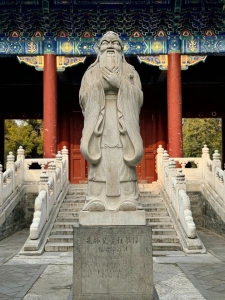
Beijing Temple of Confucius Map
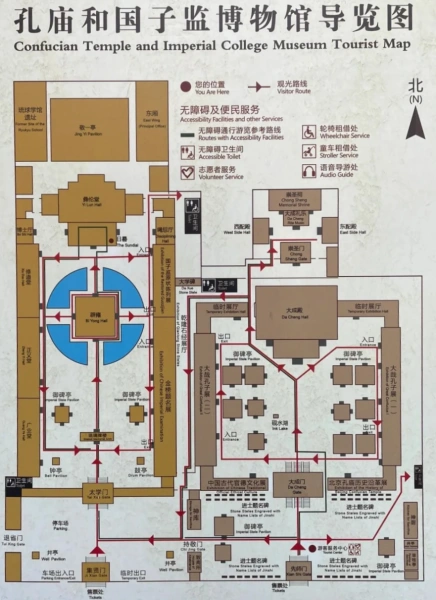
Why You Should Visit Beijing Temple of Confucius
A Long History and Deep Cultural Heritage
Founded in the sixth year of the Dade era of the Yuan Dynasty (1302), the Beijing Temple of Confucius has undergone multiple renovations and expansions during the Yuan, Ming, and Qing dynasties. It evolved into the grand structure we see today. The temple is not just a site for Confucian worship but also a living witness to China’s ancient imperial examination system. Many imperial scholars’ names and achievements are inscribed on stone tablets, making it a significant repository for researchers studying China’s historical examination practices.
Unique Architectural Style and Historical Value
The temple’s layout is rigorous, with a central axis running north to south, flanked by symmetrical structures and well-defined layers. Key buildings such as the Dacheng Hall and the Chongsheng Shrine feature yellow glazed tile roofs, symbolizing imperial honor. Dacheng Hall, the main hall of the temple, stands out with its grand scale and imposing presence, showcasing the brilliance and craftsmanship of ancient Chinese architecture.
An Important Role in Cultural Transmission
The Beijing Temple of Confucius is not merely a collection of ancient buildings; it is a cultural repository. The site preserves stone inscriptions of Confucian classics like “The Analects,” “The Great Learning,” and “The Doctrine of the Mean.” These inscriptions are not only masterpieces of calligraphy but also vital carriers of Confucian thought. Every year on Confucius’ birthday, a grand sacrificial ceremony is held here, demonstrating the enduring reverence for the Sage and his teachings.
Top Things to Do in Beijing Temple of Confucius
Main Attractions
Jinshi Stone Tablets
One of the most striking features inside the Beijing Temple of Confucius is the collection of Jinshi Stone Tablets. These tablets record the names and native places of scholars who passed the highest level of the imperial examination, from the Yuan to the Qing dynasties. A total of 198 stone steles document the names of over 50,000 Jinshi, including many famous historical figures. These stone records serve as tangible evidence of China’s ancient examination system and are valuable resources for studying social class mobility, cultural flow, and regional talent distribution. Walking among the tablet forest offers a unique journey back in time, allowing visitors to feel the honor and excitement of scholars achieving their academic dreams.
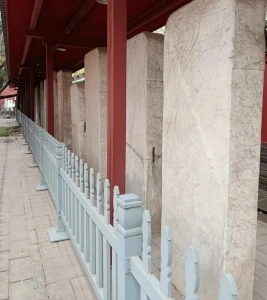
Dacheng Hall
Dacheng Hall is the central structure of the Beijing Temple of Confucius and its most majestic building. Built atop a raised platform, the hall features a yellow-glazed roof with elegantly upturned eaves, symbolizing Confucius’ supreme status in Confucian culture. Inside, a statue of Confucius stands solemnly, surrounded by stone plaques and steles honoring him, including inscriptions personally written by emperors Kangxi and Qianlong. During major sacrificial ceremonies, grand rituals are still performed here, preserving the site’s atmosphere of deep respect. Dacheng Hall not only exemplifies the artistic excellence of ancient palace architecture but also offers profound insights into Confucian ceremonial traditions.
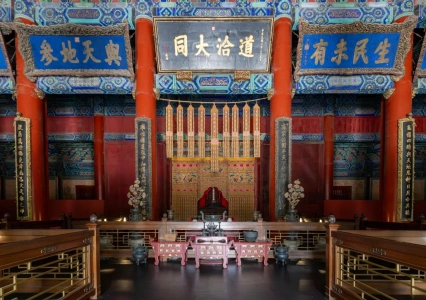
Qianlong Stone Classics Exhibition Hall
The Qianlong Stone Classics Exhibition Hall showcases stone-carved versions of Confucian classics commissioned during Emperor Qianlong’s reign in the Qing Dynasty. Carved onto 114 massive stone tablets, the inscriptions cover key works such as the “Four Books,” the “Five Classics,” and many other important Confucian texts, totaling more than 600,000 characters. The exquisite craftsmanship and precise script reflect the Qing Dynasty’s emphasis on academic orthodoxy and cultural preservation. Visiting this hall and reading the carved classics is a unique experience, offering a profound connection to traditional wisdom across the ages.
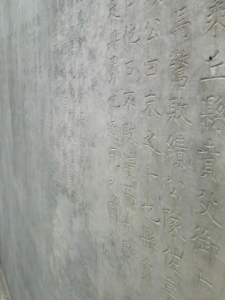
Beijing Temple of Confucius Ticket Guide
Ticket Prices for Beijing Temple of Confucius
- Adults: 30 RMB.
- Students: 15 RMB, available for undergraduate and lower-level students.
- Opening Hours: Tuesday to Sunday, 9:00 AM to 5:00 PM (last entry at 4:30 PM); closed on Mondays (except for Chinese public holidays).
Ticket Purchasing Channels
- Online: Available up to 7 days in advance through the official WeChat accounts.
- On-site: Purchase tickets at the ticket office at the entrance of the attraction.
Beijing Temple of Confucius Guided Tours
The Beijing Temple of Confucius offers audio guide devices to help visitors better understand the site’s rich history.
- Supported Languages: Chinese, English, Japanese, Korean, and French.
- Fees: 20 RMB for Chinese; 30 RMB for other languages.
- Deposit: 200 RMB.
Recommended Touring Route for Beijing Temple of Confucius
The Confucius Temple and the Imperial College are usually visited together, and they are often considered a single attraction. The recommended touring route is as follows:
Xianshi Gate (Starting Point) → Jinshi Stone Tablets → Dacheng Gate → Chujian Cypress → Dacheng Hall → Qianlong Stone Classics → Taixue Gate → Glazed Archway → Aotou → Biyong Hall → Shengqian Hall → Imperial College Exhibition → Honor Roll Exhibition → Jixian Gate (Ending Point)
Recommended Food Near Beijing Temple of Confucius
Xilou Wangji Beef Noodles
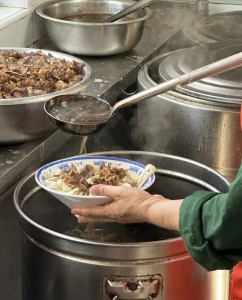
- Recommended Dish: Try the deep-fried vegetarian balls for just 7 RMB per large plate, a mix of starch and vegetables deep-fried to perfection. The beef noodles are also highly recommended.
- Address: No. 5-6 Xilou Hutong, Dongcheng District, Beijing (Apple Maps/Amap)
- Business Hours: Monday to Sunday, 8:30 AM – 9:00 PM
- Average Cost: 21 RMB
Convenient Milk Station

- Recommended Item: Highly recommend their milk curds—affordable and delicious.
- Address: No. 83 Andingmen Inner Street, Andingmen Residential District, Dongcheng District, Beijing (Apple Maps/Amap)
- Business Hours: Monday to Sunday, 9:00 AM – 11:00 PM
- Average Cost: 10 RMB
Chabingzhai
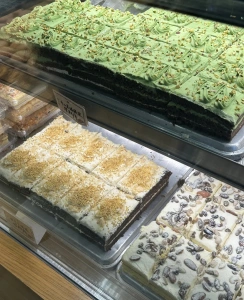
- Recommended Dish: Their signature pistachio milk cake is a must-try. Also, the jasmine cheese tart is delightful, with a non-sweet crust and rich but not overwhelming flavor.
- Address: No. 167 Yonghegong Street, Dongcheng District, Beijing (Apple Maps/Amap)
- Business Hours: Monday to Sunday, 10:00 AM – 7:00 PM
- Average Cost: 10 RMB
How to Get to Beijing Temple of Confucius from Downtown Beijing
There is a nearby subway station, making the subway the most convenient way to reach the Beijing Temple of Confucius. After getting off the subway, it takes only about 10 minutes on foot to reach the temple.
Subway
Multiple subway lines can take you to the Beijing Temple of Confucius. You can take Subway Line 2 or Line 5 and get off at Yonghegong Station. Exit through Exit F (Southeast Exit) and walk for about 10 minutes to reach the temple. The entire trip usually takes about 40 minutes and costs approximately 3 RMB.
- Transportation Card Purchase: Klook Deals, KKday Offers
Bus
Several bus routes from downtown Beijing go directly to the Beijing Temple of Confucius. You can take Bus 13 or 84 and get off at Guozijian Station. Alternatively, you can take Bus 116 or 117 and get off at Yonghegong Station. Buses 104, 108, 113, 124, and 141 all stop at Andingmen Inner Station.
- Transportation Card Purchase: Klook Deals, KKday Offers
Taxi/Rideshare
Taking a taxi or using a rideshare service from downtown Beijing typically takes around 30 minutes and costs about 30 RMB.
FAQ
Yes, most of the paths are flat, making it convenient for strollers and wheelchairs. Additionally, the Beijing Temple of Confucius offers wheelchair and stroller rental services.
The Beijing Temple of Confucius provides luggage storage services near the entrance.
Essential Beijing Travel Resources
- Comprehensive Beijing Travel Guide 📖
- Beijing Travel Recommendations 🏙️
- Hotel Recommendations 🏨
- Transportation Guides ✈️ 🚇 🚄 🚆
- Essential Travel Tips & Tools 🗺️ 🍜 📱 💸 🌤️ 💊
- 🗺️ Beijing Maps
- 🍜 Beijing Food and Dining Guide
- 🍜 Peking Duck in Beijing Guide
- 📱 Essential Travel Apps
- 💸 China Tax Refund Guide
- 🌤️ Beijing Weather Guide
- 💊 Essential Medicines for Traveling
- 🛍️ Travel Deals China
- 🔌 China Plug Types and Power Adapter Guide
- 📶 How to Use eSIM China
- 🧳 Packing List and Travel Checklist

 English (US)
English (US)
 繁體中文
繁體中文 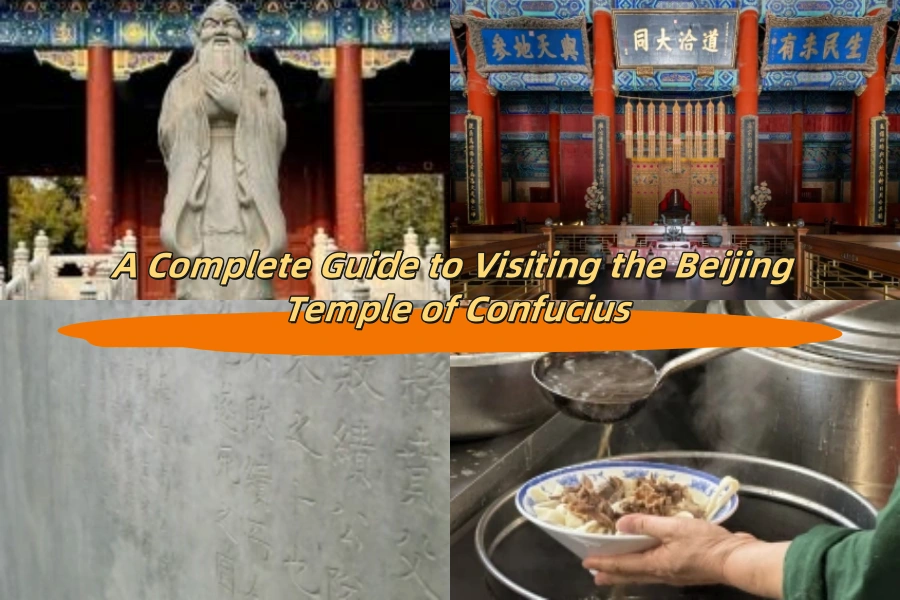
Comment (0)